
Tibetan Buddhism is a form of Buddhism practiced in Tibet and Mongolia. It also has a sizable number of adherents in the areas surrounding the Himalayas, including the Indian regions of Ladakh, Sikkim, and Arunachal Pradesh, as well as Bhutan and Nepal. Smaller groups of practitioners can be found in Central Asia, Xinjiang, Inner Mongolia, and some regions of Russia, such as Tuva, Buryatia, and Kalmykia.
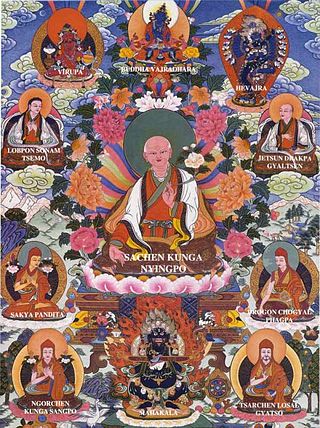
The Sakya school is one of four major schools of Tibetan Buddhism, the others being the Nyingma, Kagyu, and Gelug. It is one of the Red Hat Orders along with the Nyingma and Kagyu.

The Gelug is the newest of the four major schools of Tibetan Buddhism. It was founded by Je Tsongkhapa (1357–1419), a Tibetan philosopher, tantric yogi and lama and further expanded and developed by his disciples.

The Kadam school of Tibetan Buddhism was an 11th century Buddhist tradition founded by the great Bengali master Atiśa (982-1054) and his students like Dromtön (1005–1064), a Tibetan Buddhist lay master. The Kadampa stressed compassion, pure discipline and study.

Atīśa Dīpaṅkara Śrījñāna or Atīśa Dīpaṃkara Śrījñāna was a Buddhist religious leader and master. He is generally associated with his work carried out at the Vikramashila monastery in Bihar. He was one of the major figures in the spread of 11th-century Mahayana and Vajrayana Buddhism in Asia and inspired Buddhist thought from Tibet to Sumatra. He is recognised as one of the greatest figures of medieval Buddhism. Atiśa's chief disciple, Dromtön, was the founder of the Kadam school, one of the New Translation schools of Tibetan Buddhism, later supplanted by the Gelug tradition in the 14th century which adopted its teachings and absorbed its monasteries.

The Tibetan Buddhist canon is a loosely defined list of sacred texts recognized by various sects of Tibetan Buddhism. In addition to sutrayana texts from Early Buddhist schools and Mahayana sources, the Tibetan canon includes tantric texts. The Tibetan Canon underwent a final compilation in the 14th century by Buton Rinchen Drub (1290–1364).
Lamrim is a Tibetan Buddhist textual form for presenting the stages in the complete path to enlightenment as taught by Buddha. In Tibetan Buddhist history there have been many different versions of lamrim, presented by different teachers of the Nyingma, Kagyu and Gelug schools. However, all versions of the lamrim are elaborations of Atiśa's 11th-century root text A Lamp for the Path to Enlightenment (Bodhipathapradīpa).
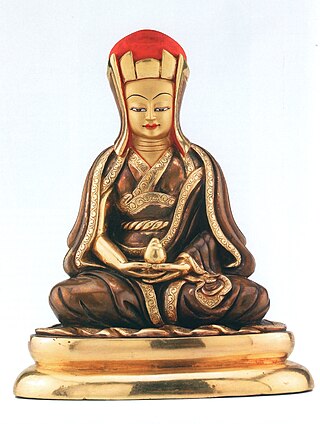
Gampopa Sönam Rinchen was the main student of Milarepa, and a Tibetan Buddhist master who codified his own master's ascetic teachings, which form the foundation of the Kagyu educational tradition. Gampopa was also a doctor and tantric master. He authored the first Lamrim text, Jewel Ornament of Liberation, and founded the Dagpo Kagyu school. He is also known as Dvagpopa, and by the titles Dakpo Lharjé "the physician from Dakpo" and Daö Zhönnu, "Candraprabhakumara".

Jamyang Khyentse Wangpo, also known by his tertön title, Pema Ösel Dongak Lingpa, was a renowned teacher, scholar and tertön of 19th-century Tibet. He was a leading figure in the Rimé movement.

Sera Monastery is one of the "great three" Gelug university monasteries of Tibet, located 1.25 miles (2.01 km) north of Lhasa and about 5 km (3.1 mi) north of the Jokhang. The other two are Ganden Monastery and Drepung Monastery. The origin of its name is attributed to a fact that during construction, the hill behind the monastery was covered with blooming wild roses.
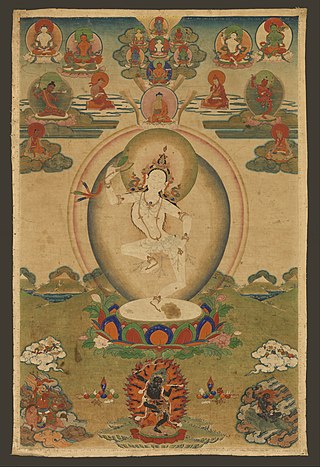
Machig Labdrön, or "Singular Mother Torch from Lab", 1055-1149) was a female Tibetan Buddhist monk believed to be a reincarnation of Yeshe Tsogyal, and the renowned 11th-century Tibetan tantric Buddhist master and yogini that originated several Tibetan lineages of the Vajrayana practice of Chöd.
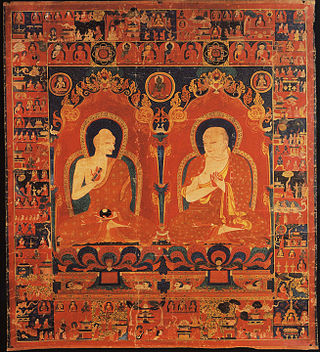
Butön Rinchen Drup, (1290–1364), 11th Abbot of Shalu Monastery, was a 14th-century Sakya master and Tibetan Buddhist leader. Shalu was the first of the major monasteries to be built by noble families of the Tsang dynasty during Tibet's great revival of Buddhism, and was an important center of the Sakya tradition. Butön was not merely a capable administrator but he is remembered to this very day as a prodigious scholar and writer and is Tibet's most celebrated historian.

Geshe Sonam Rinchen (1933–2013) was born in Trehor region of Kham in Eastern Tibet in 1933. He died in Dharamshala, India, on 5 October 2013.
Sonam is a given name. It is a Tibetan name meaning "merit". Separately, it is also a name in various Indo-Aryan languages.

Tabo Monastery is located in the Tabo village of Spiti Valley, Himachal Pradesh, northern India. It was founded in 996 CE in the Tibetan year of the Fire Ape by the Tibetan Buddhist lotsawa (translator) Rinchen Zangpo, on behalf of the king of western Himalayan Kingdom of Guge, Yeshe-Ö. Tabo is noted for being the oldest continuously operating Buddhist enclave in both India and the Himalayas. A large number of frescoes displayed on its walls depict tales from the Buddhist pantheon. There are many priceless collections of thankas, manuscripts, well-preserved statues, frescos and extensive murals which cover almost every wall. The monastery is in need of refurbishing as the wooden structures are aging and the thanka scroll paintings are fading. After the earthquake of 1975, the monastery was rebuilt, and in 1983 a new Du-kang or Assembly Hall was constructed. It is here that the 14th Dalai Lama held the Kalachakra ceremonies in 1983 and 1996. The monastery is protected by the Archaeological Survey of India (ASI) as a national historic treasure of India.

David Ross Komito is a professor of Asian Philosophy and author on the subjects of Mādhyamaka Buddhist philosophy, meditation and the psychology of religion.
Panchen Sonam Dragpa (1478–1554) was the fifteenth Ganden Tripa or throneholder of Ganden Monastery. His texts form the core curriculum for the Loseling College of Drepung Monastic University, the Shartse College of the Ganden Monastic University, and several other Gelugpa monasteries. He was taught by the second Dalai Lama, and in turn later became the teacher of the third Dalai Lama.
Geshey Gendün Rinchen, was the 69th Je Khenpo of Bhutan.
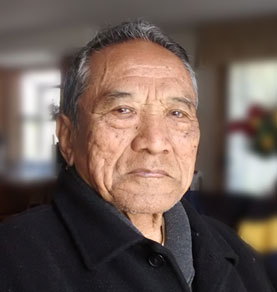
Losang Thonden was a Tibetan government official, scholar, calligrapher, and author.
The Imperial Preceptor, or Dishi was a high title and powerful post created by Kublai Khan, founder of the Yuan dynasty. It was established as part of Mongol patronage of Tibetan Buddhism and the Yuan administrative rule of Tibet.
















